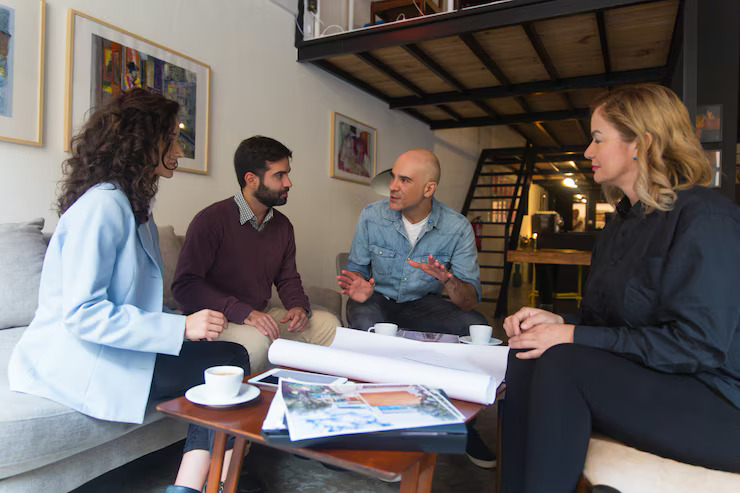Commercial Interior Design: A Practical Guide for Business Owners
Designing Workspaces That Work: Smart Interior Solutions for Modern Businesses
What is commercial interior design, and why should business owners care about it?
The answer is simple: your space affects how your business performs. Whether it’s an office, retail store, or restaurant, the layout, lighting, materials, and flow all play a direct role in productivity, customer experience, and long-term cost savings. This practical guide breaks down the types of commercial interior design, when to invest in it, and how it adds real value to your business.
What Is Commercial Interior Design?
Commercial interior design is the process of designing and organising interior spaces used for business. These include offices, restaurants, hotels, retail stores, clinics, and more. Unlike residential design, it focuses on functionality, branding, safety codes, space planning, and how people interact with the space day to day.
It’s not just about how a space looks but how well it works as well. A commercial designer balances aesthetics with real-world needs like employee flow, lighting, acoustics, and durability.

Types of Commercial Interior Design
There are several subcategories, each shaped by its use:
-
- Office Design
Focused on productivity, well-being, and layout efficiency. Includes breakout zones, meeting rooms, ergonomic workstations, and tech integration - Retail Design
Encourages customer flow and supports sales strategy. Includes product displays, foot traffic paths, and visual merchandising. - Hospitality Design
For hotels, cafes, and restaurants. Emphasises mood, experience, and brand atmosphere. - Healthcare Design
Combines functionality with comfort. Priorities hygiene, safety, and ease of navigation. - Educational & Institutional Design
Designs spaces that facilitate learning, collaboration, and access to resources. - Restaurant Design:
Balances kitchen workflow efficiency with creating the desired dining atmosphere (fast-casual vs. fine dining), durability, and brand identity. - Industrial & Warehouse Design:
Focuses on workflow optimization, heavy-duty durability, safety protocols, storage solutions, and employee well-being in large spaces. - Institutional Design:
Serves public needs with durability, safety, accessibility, and functionality. Includes schools, universities, libraries, government buildings, and religious spaces.
- Office Design
Each type has its own codes, safety requirements, and user experience goals. A skilled commercial designer knows how to adapt to each.
What Does a Commercial Designer Do?
A commercial interior designer does a lot more than pick colors and furniture. Their job is to make sure every part of the space works for your business: visually, functionally, and legally. They handle layout planning, coordinate with consultants, choose durable materials, and make sure the design meets safety and building codes.
Here’s what their role typically includes:
-
- Space planning – Making sure the layout supports how your business actually works.
- Code compliance – Ensuring everything meets fire, safety, and accessibility standards.
- Material selection – Choosing finishes that hold up to daily use and match your brand.
- Lighting and systems – Planning how lighting, HVAC, and electrical elements fit into the space.
- Project coordination – Working with contractors and consultants to keep the build on track.
Most commercial designers work closely with architects and engineers. Their focus is to turn your business needs into a space that delivers, day after day.
When Should You Invest in Commercial Interior Design?
Interior design is not just a finishing touch. Timing matters, and bringing a designer in too late can lead to higher costs and missed opportunities.
Here’s when to consider involving a designer:
-
- At the Start of a New Project If you’re opening a new branch or building from scratch, involving a designer early helps avoid costly layout changes later. They can advise on spatial zoning, lighting placement, and customer/user flow before the walls go up.
- During Relocation or ExpansionA new space comes with new dimensions, challenges, and potentials. Redesigning for optimal use ensures the space reflects your brand while serving your operations efficiently.
- When Renovating Outdated SpacesOld layouts often don’t support modern workflows. Redesigning improves both form and function, helps refresh employee morale, and can even lower operational costs.
- After Business Growth or Strategy ShiftsAs your business evolves, your space may need to shift from open layouts to private offices, or from basic amenities to client-facing experience zones.
- To Improve Brand PresenceYour interior says a lot about your business. A clean, purposeful design helps reinforce trust and consistency from the reception area to the restroom signage.
Foundations That Shape Commercial Spaces
No matter the size or purpose of your business, good commercial interior design is built on a set of core principles. These aren’t just artistic guidelines; they influence how well a space functions, how people move through it, and how your brand is experienced. When applied intentionally, they support everything from team productivity to customer perception.
Here are the 7 basics of interior design every business space benefits from:
-
- Space – How the area is used, divided, and opened up affects flow, safety, and flexibility.
- Line – Lines create structure; straight lines add order, while curves can soften or open zones.
- Form – The shapes of walls, furniture, and fixtures help define function and style.
- Light – Good lighting enhances mood, reduces strain, and draws attention to key areas.
- Colour – Colours influence how a space feels and what your brand communicates.
- Texture – Texture adds depth and contrast matte, gloss, soft, hard all shape perception.
- Pattern – Used well, patterns create consistency or highlight specific zones without clutter.
A skilled commercial designer applies these principles in a way that aligns precisely with your business’s needs and goals.
How Commercial Interior Design Adds Real Business Value
A well-designed space isn’t just aesthetic; it’s strategic. Here’s how it can directly benefit a business:
-
- Improves Employee Productivity
Spaces that reduce noise, improve lighting, and support workflow contribute to better performance and satisfaction. - Enhances Customer Experience
Whether it’s a retail store or a waiting area, a space can guide, inform, and comfort users, all of which impact behaviour and loyalty. - Supports Brand Consistency
Your colours, signage, materials, and layout reinforce your brand voice when done right; they speak before you do. - Optimises Space Usage
Better layouts often reveal hidden value in square footage, opening up room for collaboration zones, storage, or flexible work areas. - Boosts Operational Efficiency
Smart lighting placement, air flow design, and material choice can cut long-term maintenance and utility costs.
- Improves Employee Productivity
Key Things to Consider Before Hiring a Commercial Designer
To ensure your investment pays off, ask these:
-
- Have they worked in your industry before?
- Can they explain how past projects improved business outcomes?
- Do they understand the regulatory codes that apply to your building?
- How do they handle revisions, communication, and timelines?
- Can they collaborate with your architect or contractor?
Tips for Energy-Efficient Planning
Energy-Efficient Planning: A Smarter Long-Term Strategy
Good commercial interior design doesn’t stop at appearances it also considers how the space performs over time. Energy efficiency is one of the most practical ways to reduce operating costs and improve day-to-day comfort. When planned early, it becomes part of the layout, not an afterthought.
Here’s where smart planning makes a difference:
-
- Natural light is used strategically to reduce dependence on artificial lighting.
- LED systems and motion sensors help lower electricity use without compromising ambience.
- Materials with thermal insulation support year-round comfort and reduce HVAC strain.
- Zoned HVAC systems allow for more targeted climate control and less energy waste.
None of these decisions require luxury budgets, just informed choices. And when efficiency is built into the design from the start, it pays off with lower bills, longer-lasting systems, and a better user experience.
Looking for a partner who can design smart and build well? Abdullah and Associates is ready to help. Click Here to get in touch.
Frequently Asked Questions
What is a commercial interior design?
It’s the process of designing interiors for commercial use offices, stores, restaurants, etc. with a focus on function, compliance, and brand alignment.
When should you invest in commercial interior design?
When starting a new build, relocating, renovating, or evolving your business operations and space needs.
What are the 7 basics of interior design?
Space, line, form, light, colour, texture, and pattern.
What does a commercial designer do?
They plan, coordinate, and execute the design of commercial spaces balancing aesthetics, code compliance, layout, and user needs.
What are the types of commercial interior design?
Office, retail, hospitality, healthcare, and institutional interiors are the major categories.

